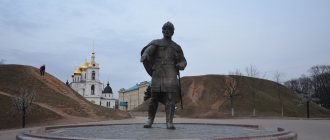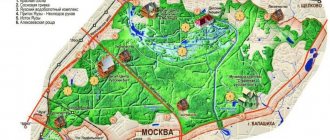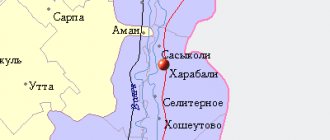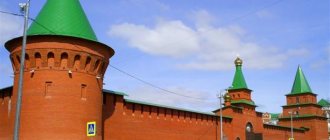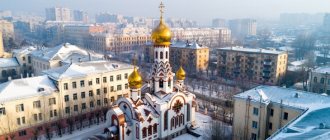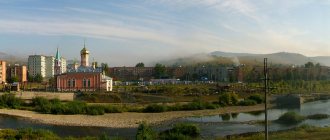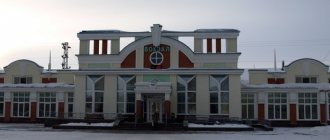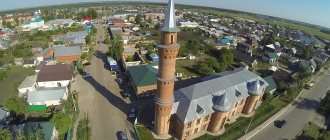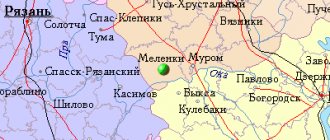City of Kuvandyk. the administrative center of the Kuvandyk district, located 200 km from Orenburg and 100 km from Orsk. in the valley of the Sakmara River and surrounded by spurs of the Guberlinsky Mountains. Loosely translated from Bashkir, Kuvandyk means “valley of happiness.”
The first peasants from Russian and Ukrainian provinces settled in the valley of the Kuvandychka River, near its confluence with Sakmara, at the end of the 19th century, calling the village Pokrovka. In 1913 there were about three dozen houses here.
In 1915, during the construction of the Orenburg-Orsk-Troitsk railway, a station appeared, which was supposed to be called Pokrovka after the name of the village. But it turned out that the list of stations already had plenty of Pokrovok, so the station was named after the local river Kuvandyk. Over time, this name spread to the station village and Pokrovka, which merged with it. Two years later, in 1917, the construction of the Kuvandyk locomotive depot was completed. The first freight and passenger train arrived at the station. The railway line was then extended to Sara station. True, regular train service did not begin here soon.
The growth of Kuvandyk is associated with the rapid development of domestic aviation; aluminum was required, but increasing its production is impossible without cryolite, which is obtained from fluorspar in special factories.
Even in the pre-war years, prospectors chose a site for the construction of a cryolite plant a few kilometers from Kuvandyk. The construction of the first workshops began. But due to the war, construction was suspended and resumed only in 1946. There are only two such enterprises in our country, and one of them, the South Ural Cryolite Plant, operates near Kuvandyk. At the other end of the city, on the banks of the Sakmara River, there is the Kuvandyk Mechanical Press Plant. The products of local factories YuUKZ and KZMP are in great demand on the world market.
On August 24, 1953, the workers' village of Kuvandyk was transformed into a city.
The local museum has many exhibits telling about the history of Kuvandyk, the life of the city and the region... One of the stands is dedicated to the exploits of fellow countrymen - Heroes of the Soviet Union. There are eight of them. This is a tanker, junior lieutenant Boris Grebennikov, whose name is given to one of the streets of Kuvandyk. These are pilots, squadron commanders Vasily Kozenkov and Nikolai Evsyukov, machine gun platoon commander Dmitry Slashchov, machine gun company commander Mikhail Gubin, artilleryman Nikolai Yezhov, participant in the assault on Berlin, Lieutenant Colonel Pavel Davydov, and junior lieutenant Ivan Nazarov.
The surroundings of Kuvandyk are very picturesque, the places north of the city, along the banks of Sakmara, are especially beautiful. It is here, on a wooded area between the river bank and the mountains, that the buildings of the Sakmara holiday home are located. In the neighborhood there are rocky peaks with bizarre outlines - one of them resembles an ancient castle, another steeply drops to the water, the third is pointed, cone-shaped...
Sources:
- “Guide to the Orenburg region. First edition” Printed at JSC IPO “Lev Tolstoy”, Tula. 2006
- V.G. Altov “Cities of the Orenburg Region”. Chelyabinsk, South Ural book. publishing house, 1974. 254 p. with ill.
- Photos: Rakovsky Sergey
Trails
In 2012, Kuvandyk, which was then called Dolina, was recognized as the best resort for beginner skiers. This was largely due to the presence of gentle and wide slopes.
Since then, nothing much has changed in this regard, except that a snow park with figures for extreme skiing and tubing tracks were added to the existing tracks.
Today, Kuvandyk365 offers 12 routes for beginners and experienced athletes. The minimum length is 250 meters, the maximum is 2 kilometers 500 meters.
The main slope, which is 12 kilometers long, is divided into several zones: for training, for advanced users, for free skiing and snowboarding, and sports tracks. In the evening, all slopes are additionally illuminated.
© GLK "Kuvandyk365" VKontakte
Attractions
Unfortunately, there are no famous places in the city itself. But a walk through the streets is a must – the atmosphere is unusual. In addition, it is definitely worth visiting the Kuvandyk Museum of History and Local Lore . The museum first opened its doors on April 30, 1966. At the end of the 70s, the museum was allocated only two rooms in an old hotel on Mira Avenue. Today the Museum and Exhibition Center has an area of more than 400 square meters! This includes six exhibition halls, three exhibition halls for displaying the works of artists and folk artists, as well as a storage facility.
Photo by: Rustam Kadergulov
Kuvandyk is interesting to tourists for its surroundings. The city is surrounded by picturesque hills, which are actually the southern point of the Ural Mountains . Climbing one of the hills surrounding the city (for example, Tornatau ) , you can see the panorama of the city. From above it looks very picturesque. The city, surrounded on all sides by low mountains, is located as if in a huge bowl. in the Orenburg region comparable in beauty to Kuvandyk .
Photo by: Rustam Kadergulov
Mount Oslotau , which resembles a pyramid in outline, especially stands out Here and there rocks come to the surface. For example, the Turtle Rock, whose outline resembles this reptile. The Sakmara River , popular among water tourists, flows through the city In summer, the hills near Kuvandyk are a great place for hang gliding.
In winter, ski lovers from all over the Orenburg region come to Kuvandyk. The Kuvandyk 365 ski complex is located here . It is located five kilometers from the city in the valley of the Sakmara River. At the Kuvandyk 365 ski resort there is a hotel, a cafe, and a bar. Skis can be rented.
Kuvandyk
(Orenburg region)
OKATO code:
53414
Founded:
con.
19th century Urban-type settlement since:
1939
City since:
1953 City of regional subordination
Center:
Kuvandyk district
Telephone code (reference phone)
| 35361***** | 20-5-99 |
Deviation from Moscow time, hours:
2
Geographic latitude:
51°29′
Geographic longitude:
57°21′
Altitude above sea level, meters:
210 Sunrise and sunset times in the city of Kuvandyk
Webcam at the Kuvandyk ski resort
For greater convenience of visitors, the resort is equipped with two webcams. One device is located near the towing ropeway-1, and the second is located next to the BKD-2. The recordings are broadcast online on the complex’s website.
Resort webcam broadcast
© GLK "Kuvandyk365" VKontakte
Cities
The city of Kuvandyk is a city in Russia, the administrative center of the Kuvandyk district of the Orenburg region. The population as of the end of 2011 is actually 28.1 thousand people, the area is 42.06 km?. The city is located on the Sakmara River, 194 km from Orenburg. For many years now, Kuvandyk has been the center of one of the largest districts in the region. Its dimensions are six thousand square meters. kilometers. There are 6 collective farms and 9 state farms in the region. More than half a million hectares of land are assigned to them. On October 24, 1983, the city of Kuvandyk was classified as a city of regional subordination. The head of the city is Viktor Dmitrievich Paukov. Kuvandy residents - Heroes of the Soviet Union: tankman, junior lieutenant Boris Grebennikov, whose name is one of the streets of Kuvandyk, pilots, squadron commanders Vasily Kozenkov and Nikolai Evsyukov, machine gun platoon commander Dmitry Slashchev, machine gun company commander Mikhail Gubin, artilleryman Nikolai Yezhov, participant in the assault on Berlin Lieutenant Colonel Pavel Davydov and Junior Lieutenant Ivan Nazarov. The city has 4 secondary and 1 eight-year schools, a district House of Culture and 3 clubs, a cinema "Kriolit", a music school, a House of Pioneers, 2 stadiums, a local history museum.
The surroundings of Kuvandyk are very picturesque, especially to the north of the city, along the banks of the river. Sakmara. There are rocky peaks with bizarre shapes (pointed, cone-shaped, steeply falling to the water, etc.). Here, on a wooded area between the river bank and the mountains, the buildings of the Sakmara holiday home are located. At the end of the 19th century, on the site of Kuvandyk, settlers from the European part of Russia and Ukraine founded the village of Pokrovka. When in 1915 a railway station appeared in the village, which, in order to avoid duplication of station names, was called “Kuvandyk”, named after the local river Kuvandychka. “Valley of Happiness” is what the residents of Kuvandyk call their city. They say that this is exactly what this name sounds like translated from Bashkir.
Education in the city of Kuvandyk
The city has a number of secondary specialized, general education and preschool institutions. There are no institutions of higher professional education in the city, so future students go to other cities to enroll.
Economy of the city of Kuvandyk
The main industrial enterprises of the city: South Ural Cryolite - production of forging and pressing and metalworking equipment, as well as products for construction, the construction industry, agriculture and housing and communal services. TVG Orenburg Down Talisman - production of Orenburg down scarves, Orenburg webs, knitted stoles YuUKZ and KZMP - the main enterprises of the city. But there are others - a grain collection point, a railway station, a down-knitting production, a creamery. The Pobeda state farm is located in Kuvandyk. Kuvandyk owes its rapid growth especially to the rapid development of domestic aviation. Its development is unthinkable without increasing aluminum production, and aluminum cannot be smelted without cryolite - a white powder that is obtained from fluorspar in special factories. There are two such enterprises in our country. One of them, the South Ural Cryolite Plant, is located in Kuvandyk. The high-quality cryolite it produces is used in many aluminum smelters in the country. And those who work in the shops and departments of this advanced enterprise legitimately believe that many aircraft in the country were built with their participation. Even in the pre-war years, prospectors chose a site for the construction of a cryolite plant a few kilometers from Kuvandyk. The construction of the first workshops began. But due to the war, construction was suspended and resumed only in 1946. On November 6, 1954, on the eve of the celebration of the 37th anniversary of the Great October Socialist Revolution, a man in working overalls, a senior dryer at the South Ural cryolite plant, stood up on the stage of the House of Culture, where the ceremonial meeting of the Kuvandyk City Council was taking place. This is how the South Ural cryolite began. Today, the plant’s staff, through modernization of equipment and the use of advanced technology, has more than doubled its design capacity. The reconstruction of the plant is in full swing, production areas are being expanded, and equipment is being updated. In 1976, when the reconstruction is completely completed, the enterprise's capacity will double again. And by 1954 it will triple! The products of the Kuvandyk plant are in great demand on the world market. It is bought in Yugoslavia, Poland and other countries. [edit] Kuvandyk Mechanical Press Plant At the beginning of the Great Patriotic War, the “Red Stamper” artel was evacuated from Kyiv to Kuvandyk. The equipment was placed in buildings left over from the timber rafting organization. Day and night, workers and specialists assembled machines and stamping presses. And just a few days after their arrival, the artel began to provide the products needed for the front. After the war, workers just as quickly switched to producing peaceful products. By that time, the artel had been transformed into a hardware and mechanical plant, and later into a mechanical press plant. Today, the main product of the plant is universal press shears for cutting metal of a wide variety of profiles. Kuvandyk provides up to one and a half thousand of these presses annually to the national economy of the country. It is not so easy to find a corner of the country where there would not be press shears with the KZMP brand. For example, the plant sent a large batch of equipment to world-famous auto giants in Tolyatti and Naberezhnye Chelny. The Kuvandyk brand is known far beyond the borders of the Union.
History of the city of Kuvandyk
At the end of the 19th century, peasants from Russian and Ukrainian provinces moved east, in search of the promised land, and walkers from distant lands came to the valley of the Ural river Kuvandychka. They liked the places near Sakmara. They bought land and began to settle along the shores of the lake. The village was named Pokrovka. In 1913 there were about three dozen houses here. The impetus for the development of the new settlement was given by the construction of the Orenburg-Orsk-Troitsk railway. In 1915, a railway station was built, which was supposed to be called Pokrovka after the village. But it turned out that there were already plenty of Pokrovok stations on the list. Then they remembered the local river Kuvandychka, and it was then that the word “Kuvandyk” first appeared on the station building. From then on, the station village, and then the village of Pokrovka, began to be called the same. Two years later, in 1917, the construction of the Kuvandyk locomotive depot was completed. The first freight and passenger train arrived at the station. The railway line was then extended to Sara station. True, regular train service did not begin here soon. At the end of 1917, power in Orenburg was seized by the Cossack ataman A. Dutov. In February 1918, a volost revolutionary committee was created in Kuvandyk. It was led by the Bolsheviks Nesterov and Sinyagin. At the call of the Revolutionary Committee, a Red Guard detachment of 67 people, mostly railway workers, was formed in the village. Nikolai Proskin was elected commander of the detachment. A little later, another detachment appeared. The Revolutionary Committee united them under the leadership of Alexei Dudarev. On June 22, 1918, White Cossacks led by Dutov attacked Kuvandyk from Ilyinka. 37 Red Guards and Dudarev died. They were buried in a mass grave in the southern part of the city, and later the remains were transferred to the center of Kuvandyk. In 1963, a monument to the fighters for Soviet power was unveiled. On July 1, 1918, at dawn, the Dutovites made a new raid on Kuvandyk. On July 3, the Red Guard detachment, together with the units that retreated from Orenburg, had to leave the city and retreat to Orsk. In February 1919, soldiers of the 215th regiment of the 24th Simbirsk Iron Division entered Kuvandyk. But in the spring, when Kolchak’s offensive began, he had to retreat again. On August 13, 1919, the offensive of the 1st Army began under the command of G.V. Zinoviev. On August 28, Kuvandyk was finally liberated from the Whites and became Soviet. On January 15, 1921, after the restoration and laying of new tracks, the Orskaya branch to the Krutorozhino station was officially put into operation and included in the Tashkent Railway. Due to repair, restoration and construction work on the railway, the population of Kuvandyk increased again. Such influxes of population occurred later - at the end of the thirties in connection with the creation of a timber rafting office in Kuvandyk, and then when new enterprises settled here. Part of the timber rafted along the Sakmara from Bashkiria to Orenburg was delayed in Kuvandyk, went to sawing and was sent from here to Orsk and to the villages of the eastern volosts. A timber rafting area is located on the banks of the Sakmara River. After the locomotive depot and station, it was the largest enterprise in the city. On August 24, 1953, the working village of Kuvandyk was transformed into a city (with a population of 23 thousand people). In December 2000, the city of Kuvandyk, united with the Kuvandyk district, was transformed into the municipal entity “Kuvandyk city and Kuvandyk district”.
| Coat of arms of the city of Kuvandyk - In an azure field under a silver peak, three times concave in the form of hills on top of a scale-like curved silver belt placed in the lower right corner - a golden horse walking and turning around. Approved by decision of the Council of Deputies dated December 24, 2003 #250. | Flag cities Kuvandyk — A rectangular blue panel with a width to length ratio of 2:3, reproducing the figures of the coat of arms - along the upper edge there is a white stripe of complex shape, forming the outlines of mountain peaks and on the main, blue part, an image of a yellow horse entering a white stream. Rationale for symbolism: The flag was designed based on the coat of arms of the Kuvandyk region. The composition of the flag is based on the legend of the “Valley of Happiness”. “In ancient times, in the Guberlinsky mountains, the Bashkir guy Ramazan was looking for stones with which he could sharpen scythes, knives and other tools of cattle breeders. On the bank of a mountain stream, he left his horse on a lawn with lush, silky grass, and he himself began to wander along the ridges. "Beylau!" (touchstone) - he exclaimed enthusiastically, having found a whole scattering of stones he needed. He picked it up in a bag, put it on his shoulders and went to the river. There was no horse. Ramazan searched for a horse for a long time and he wandered into a completely unfamiliar, but fertile place. The forested valley was cut through by a river with spring water as clear as a tear. Along the shore there is a rich variety of herbs. The herbs are soft, juicy, thick. Only the chirping of birds and the murmuring song of the river broke the silence. And somehow my soul seemed to feel better. And then the horse neighed. Out of a thousand horse voices, Ramazan would have recognized this voice. Joy overflowed, and then he said to the river - “Kuvandychka” - joyful. Ramadan brought people from his tribe to its shores. They agreed that this place was truly joyful and settled here.” Since then, residents have called their city “Valley of Happiness.” Blue color is a symbol of truth, honor and virtue, clear skies and expanses of water. Yellow color (gold) is a symbol of the highest value, wealth, greatness, constancy, strength, strength, generosity, intelligence and sunlight. White color (silver) is a symbol of simplicity, perfection, wisdom, nobility, peace and mutual cooperation. Author group: idea of the flag: Konstantin Mochenov (Khimki); rationale for symbolism: Galina Tunik (Moscow); artist: Robert Malanichev (Moscow); computer design: Oksana Afanasyeva (Moscow). Approved by the decision of the Council of Deputies of the Kuvandyk district municipality (#308/200-SD) dated April 30, 2008. |
Prices at the Kuvandyk ski resort in 2021
Prices for using the ski lift at the resort depend on the type of device. So, for example, a lift on a tow ropeway (BKD-1) will cost a Kuvandyk client 75 rubles, on a support-free lift (aka baby elevator) - 40 rubles.
Monday to Thursday is low season, Friday to Sunday and holidays is high season.
© GLK "Kuvandyk365" VKontakte
Rental prices
There is an equipment rental service on the territory of the Kuvandyk365 ski resort.
- One hour of renting a ski or snowboard set will cost an adult 200 rubles, two hours - 360 rubles, three hours - half a thousand Russian rubles, 5 hours - 750 rubles, use for a whole day - 850 rubles, two days - 1,530 rubles and three days - 2 thousand 140 rubles.
- An hour's rental of a set for children will cost 150 rubles, two hours - 270 rubles, three - 360 rubles, five - 540 rubles, rental of equipment for a whole day - 630 rubles, two days - 1,150 rubles and three days - one thousand 600 rubles.
- If you come to the ski resort with your own boots, you pay only 50% of the indicated cost of a snowboard or skis; if you bring your own skis or snowboard, you pay half of the indicated amount for boots.
- save a little if you rent a set for the whole day (relevant only for the low season). In this case, an adult will cost 500 rubles, and a child – 350 rubles.
- As for additional equipment, a helmet will cost 100 rubles per hour, for the whole day - 250 rubles, the same conditions apply to the rental of glasses , for an hour's use of poles you will need to pay 50 rubles, for the whole day - 150 rubles.
- Prices for children's equipment are lower: helmet - 50 rubles per hour, 150 rubles for the whole day, glasses - 50 and 150 rubles, poles - 30 and 100 rubles.
- Tube rental per hour - 250 rubles.
The complex's instructors will help visitors master snowboarding or alpine skiing from scratch or improve their skills. It is better to find out prices for these services by phone or directly on site.
© GLK "Kuvandyk365" VKontakte
Prices on the official website of the Kuvandyk ski resort
